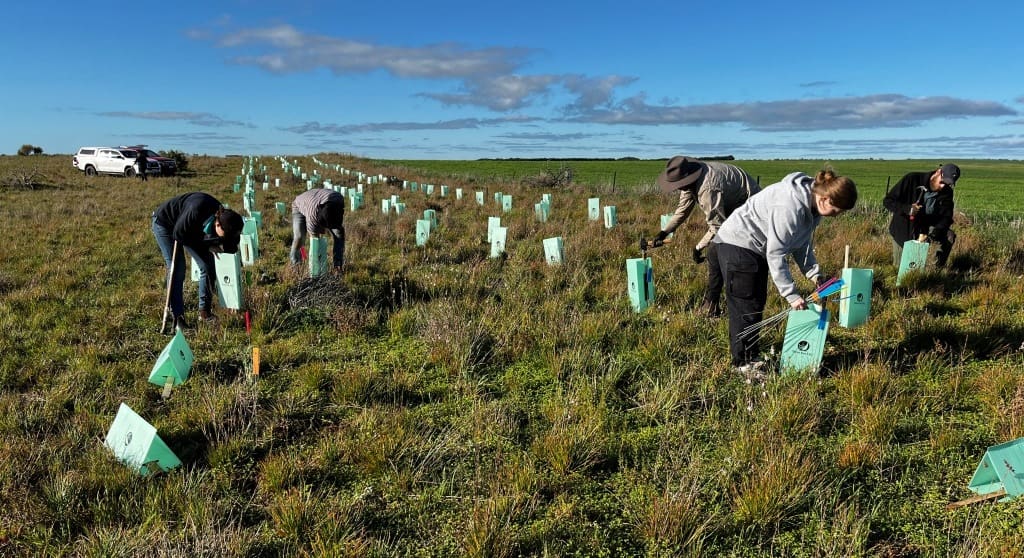
Planting trees at Port Giles that provide food sources for the Sarcophaga villeneuveana fly which preys on invasive conical snails. Photo: Dr Kym Perry
NATIVE vegetation could help boost the effectiveness of a world-first program using a parasitic fly to control a pest snail in South Australian crops.
Researchers, farmers and community volunteers are planting native plants thought to benefit populations of the fly, Sarcophaga villeneuveana which preys on invasive conical snails.
The snails, which hail from Mediterranean regions, are major pests of pastures and grain crops because they feed on seedlings in autumn and winter and contaminate harvested grain.
They are harder to control than round-shelled snails because their habit is to hide under rocks and logs, and inside plants.
Being grain-shaped, they are also harder to separate from grain post-harvest.
Following early research, the parasitic fly was sourced from southern France and established on Yorke Peninsula in several releases from 2000 to 2004.
Initially, the impact was disappointing. with average parasitism rates of less than 3 percent.
Researchers from CSIRO and SARDI wanted to know why.
One of those researchers is SARDI senior research entomologist Dr Kym Perry, who worked with Dr Kate Muirhead to breed the flies and release them at target sites.
“We bred 50,000 flies in the laboratory over two years; there were hundreds of containers of flies,” Dr Perry said.
The mass-reared flies were released in main target areas – the western Eyre Peninsula and new parts of Yorke Peninsula – and, more recently, south-eastern SA.
Follow-up research on Yorke Peninsula found the fly was not doing very well in areas where there was not a lot of vegetation nearby.
“At some individual sites, it was doing exceptionally well, with up to 30-50pc parasitisation in areas bordering with native vegetation with flowers in spring and summer.
“We hypothesised that flies need the resources from flowers – nectar and pollen – and perhaps shelter, to perform really well.
“The nectar and pollen contain nutrients that enhance adult reproduction and prolong lifespan.”
Dr Perry said selecting release sites with native vegetation flowering when flies were active had the potential to enhance establishment and parasitism.
“Access to local resources probably helps flies in several ways.
“If they don’t need to disperse as quickly in search of food, this might increase the likelihood of mating successfully, and allow more to search for their snail prey.”
The researchers believe their use of S villeneuveana is the world’s only fly-based biocontrol program for terrestrial snail pests.
The project, which has plans to expand into Western Australia, began in 2022 and will finish in 2025.
It is supported by investment from the Grains Research and Development Corporation, South Australian Grain Industry Trust, and Viterra.
The work is a collaboration between SARDI, the University of Adelaide, Trees for Life, Viterra and Grain Producers SA.
As part of the program, Dr Perry and the team have established five research and demonstration sites around the Yorke Peninsula region.
These sites have been planted with strips of native vegetation designed to benefit the parasitic flies.
 Fly and snail populations will be monitored over time to investigate whether a targeted revegetation strategy can boost biological control of pest snails.
Fly and snail populations will be monitored over time to investigate whether a targeted revegetation strategy can boost biological control of pest snails.
“Together with Trees for Life, we have designed a suite of plant species endemic to the Yorke Peninsula region that provide a continuous sequence of flowers from spring until the end of summer, when flies are active.
“The selected flowers are accessible to flies, which have short mouthparts.”
At Port Giles, Ardrossan and sites near Yorketown during the winters of 2022 and 2023, volunteers from Viterra and GPSA as welll as local farmers helped plant tubestock of native trees, shrubs, ground covers and daisies propagated by Trees for Life.
“If this strategy works well, planting small areas of native vegetation in non-cropped areas to act as fly nurseries could become another tool to help suppress conical snails.”
The research sites will be used as demonstration sites to promote the concept to growers and encourage hands-on engagement with farmers and community volunteers to participate in monitoring and maintaining the revegetation sites.
Grain Central: Get our free news straight to your inbox – Click here

HAVE YOUR SAY